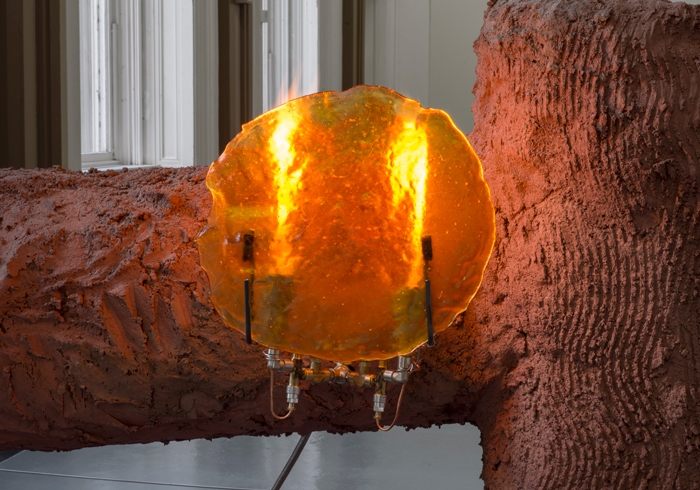Elusive narratives and bold aesthetics run through the works in British artist Aaron Angell’s latest exhibition. Villa wasp mattress demonstration (all works 2017) is a transparent inflatable mattress with crude pig’s-blood cement tiles laid out inside to resemble a hypocaust (the underfloor heating system Romans used). Sewer gas lamp demonstration sees the pig’s-blood cement take a cloddish, fencelike form. A gas canister feeds through to lamps at the front of this structure that are couched behind an enlarged ancient coin, cast in amber-coloured glass. Scalar cabbage demonstration is a giant cabbage growing within an oversize pig’s-blood cement pot. All of these works suggest antiquarian technologies, pig’s-blood cement itself an ancient formula with a remarkable capacity to endure for millennia. They also speak of bodily necessities – sleep, waste, food – admixing with matter. Their lumpen naivety belies a deep, holistic wisdom.
In stark visual contrast, A Large Wardian Case (an early type of terrarium, c. 1860) at the opening of the exhibition introduces an aesthetic Angell’s work inevitably spurns; a Victorian elegance rooted in symmetry, graceful lines and delicate ornament. Only the moss and ferns contained within it are comparatively organic. And herein lies Angell’s wonderful inversion, because once attuned to his outlandish sculptures, the erstwhile bullish case seems oddly lacking. For all its enlightened sophistication it can’t match the embodied knowledge that Angell’s bulbous yet magnanimous monuments evoke.
Add to this spiral of ideas a series of contemporary ceramic takes on cineraria (Roman containers for ash or bone) and a reverse-painted glass depicting a Vision of the purgatorial ladder with frogs and toads (the exhibition text tells us this is derived from an eleventh-century image of such a ladder) and you’re in the midst of an intriguing assemblage. Angell’s cineraria, with their gritty, imprecise bodies and pooled glazes, seems to consign their supposed contents to an afterlife devoid of conventional beauty or taste. And in this light, purgatory – where you await purification before moving on – speaks to the astute aesthetic dialogue Angell has honed within the field of ceramics, negotiating the fractious expectations of art and craft.
Of course, one challenge of GoMA is its scale and imposing neoclassical architecture. Angell aims to counter this by appropriating, as he is quoted as saying, the ‘cliché of the loft, the archipelago of stations, objects, and pools of light’, but I think this strategy meets with mixed success. Priming viewers by isolating the Wardian Case, an affective miniature of the room, works well. Elsewhere however the freestanding plastered walls, with their slightly wonky arches and combed surfaces, break the seductive dialogues of the works, not declamatory enough to shake an unnecessary white-cube overtone. But let this not detract from a remarkably enticing exhibition driven by a seductive, protean energy.
8 December 2017 – 18 March 2018
From the March 2018 issue of ArtReview
